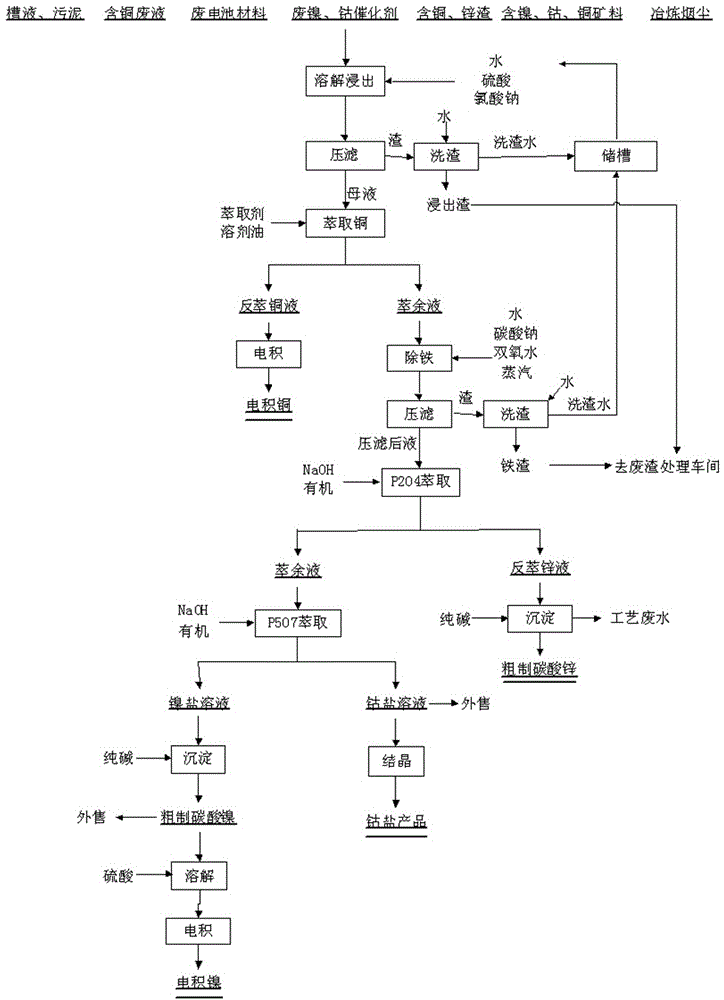Method for recycling copper, zinc, cobalt and nickel from various kinds of nonferrous metal containing waste
A non-ferrous metal and copper recovery technology, which is applied in the direction of improving process efficiency, can solve the problems of sulfide pollution, incomplete separation of valuable metals, etc., and achieve the effects of high purity, less impurities, energy saving and cost saving
- Summary
- Abstract
- Description
- Claims
- Application Information
AI Technical Summary
Problems solved by technology
Method used
Image
Examples
Embodiment 1
[0062] (1) Dissolving and leaching:
[0063] Mix 500kg of various waste materials containing non-ferrous metals, and measure the mass content of each metal, copper 2.10%, cobalt 0.56%, zinc 3.12%, iron 16.33%, nickel 1.88%. Grind the waste with a ball mill, the fineness should be below 200 mesh, then add it into 250kg of 30% sulfuric acid, add 5kg of sodium chlorate, stir at 40rpm, raise the temperature to 50°C for the first time, and react for leaching for 1 to 3 hours, then, Start to add 250kg of washing water from steps (2) and (4) dropwise, a large amount of heat will be generated, and the temperature should be controlled at 60°C. When the temperature is too high, use cooling water to cool down. The time for adding the washing water dropwise is 1-2 hours. After adding the washing water, stir for 2-3 hours, so that the soluble non-ferrous metals can be fully dissolved and leached.
[0064] (2), filter press:
[0065] Cool the dissolved leachate to below 50°C, press filter...
Embodiment 2
[0077] (1), Dissolving and leaching:
[0078] Mix 500kg of various waste materials containing non-ferrous metals, and measure the mass content of each metal, copper 2.10%, cobalt 0.56%, zinc 3.12%, iron 16.33%, nickel 1.88%. Grind the waste with a ball mill, the fineness should be below 200 mesh, then add it into 1000kg of 30% sulfuric acid, add 5kg of sodium chlorate, stir at 100rpm, raise the temperature to 50°C for the first time, and react for leaching for 1 to 3 hours, then, Start to add 2500kg of water in steps (2) and (4) dropwise, a large amount of heat will be generated, and the temperature should be controlled at 90°C. When the temperature is too high, use cooling water to cool down. The time for adding the washing water dropwise is 1-2 hours. After adding the washing water, stir for 2-3 hours, so that the soluble non-ferrous metals can be fully dissolved and leached.
[0079] (2), filter press:
[0080] Cool the dissolved leachate to below 50°C, press filter, wash...
Embodiment 3
[0092] (1), Dissolving and leaching:
[0093] Mix 500kg of various waste materials containing non-ferrous metals, and measure the mass content of each metal, copper 2.10%, cobalt 0.56%, zinc 3.12%, iron 16.33%, nickel 1.88%. Grind the waste with a ball mill, the fineness is required to be below 200 mesh, then add it to 500kg of 30% sulfuric acid, add 5kg of sodium chlorate, stir at 60rpm, raise the temperature to 50°C for the first time, and react for leaching for 1 to 3 hours, then, Start to add 1000kg of washing water from steps (2) and (4) dropwise, a large amount of heat will be generated, and the temperature should be controlled at 80°C. When the temperature is too high, use cooling water to cool down. The time for adding the washing water dropwise is 1-2 hours. After adding the washing water, stir for 2-3 hours, so that the soluble non-ferrous metals can be fully dissolved and leached.
[0094] (2), filter press:
[0095] Cool the dissolved leachate to below 50°C, pres...
PUM
 Login to View More
Login to View More Abstract
Description
Claims
Application Information
 Login to View More
Login to View More - R&D
- Intellectual Property
- Life Sciences
- Materials
- Tech Scout
- Unparalleled Data Quality
- Higher Quality Content
- 60% Fewer Hallucinations
Browse by: Latest US Patents, China's latest patents, Technical Efficacy Thesaurus, Application Domain, Technology Topic, Popular Technical Reports.
© 2025 PatSnap. All rights reserved.Legal|Privacy policy|Modern Slavery Act Transparency Statement|Sitemap|About US| Contact US: help@patsnap.com

